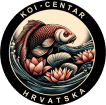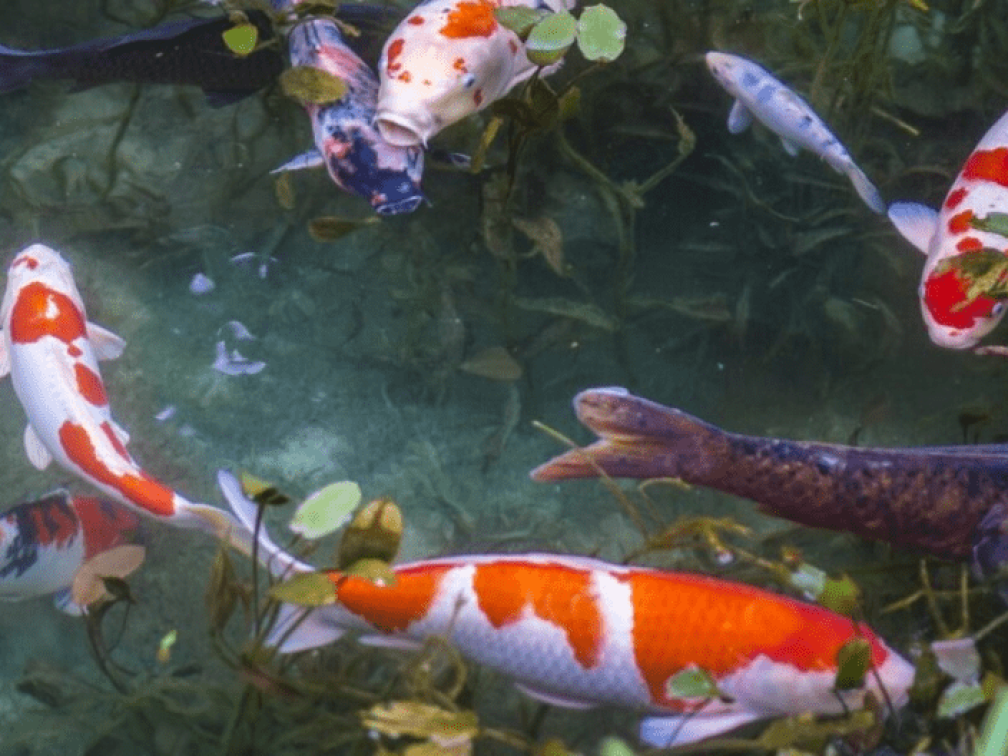
The history of koi fish dates back to around 200 BC when the Chinese invaded Japan and brought with them the common carp (Cyprinus carpio). For centuries, the Japanese used them solely as a food source. However, around the 4th century, Japanese rice farmers began to notice that their carp occasionally exhibited random colorful mutations, prompting them to selectively breed the carp. This gave rise to the modern Japanese koi fish.
Today, there are an impressive 13 main categories and over a hundred different subcategories of koi breeds. Due to their colorful patterns and various variations, they have become significant in Japanese culture and valuable to hobbyists and breeders.
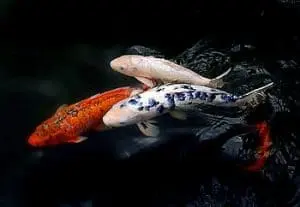
KOHAKU:
“It starts with Kohaku and ends with Kohaku,” as many koi fish hobbyists say!
When you think of koi fish, there’s a good chance that at least one of the three Gosanke breeds comes to mind. Gosanke means “three families” in Japanese. This term is used for three things that best represent the category. In the world of koi fish, it refers to Kohaku, Taisho Sanshoku, and Showa Sanshoku. These three breeds are the most important, popular, and awarded koi breeds due to their longstanding reputation for having the best color, size, and shape.
Kohaku is one of the oldest and most popular breeds of koi fish. They are recognizable by their pure white bodies and bright red markings (hi). The name Kohaku means “amber” in Japanese, describing their beautiful and fiery markings. There are many different varieties of Kohaku breed with different patterns of hi. Some of these varieties include Nidon Kohaku, Sandan Kohaku, and Tancho Kohaku.
Kohaku are typically judged based on the brightness of their color and the sharpness of the edges of their hi markings. A good Kohaku will have flawless, clean white base with sharp, consistently orange-red hi markings. The exact tone of hi is not as important as long as everything is equally shaded. Kohaku should also be large and full, which is a clear sign of a healthy fish specimen.
The exact origin of the Kohaku breed is subject to speculation, but it is widely accepted that they were created by crossing a white female with a red-headed male and a white male with a cherry blossom pattern. Another theory is that this white and red coloration appeared due to a random gene mutation in the 1880s and was so unique and attractive that people began selectively breeding for it.
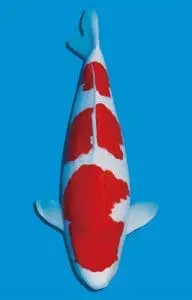
TAISHO SANSHOKU:
Also known as Taisho Sanke, or simply Taisho or Sanke, this breed is named after the period in Japan in which they were created – the Taisho Era (1912-1926). When koi fish breeders noticed small, scattered, black spots on the backs of their Kohaku, they began selectively breeding fish with these characteristics. These spots later became known as sumi.
A koi fish that has three colors is called Sanshoku. Taisho is exactly that, consisting of red, white, and black colors. A high-quality Taisho will have an immaculate, clean white base with consistent orange-red hi markings. Additionally, its sumi black spots should be ink-like and relatively evenly distributed throughout the body. It doesn’t matter if the sumi is on the red (called Tsubo Sumi) or on the white (called Kasane Sumi), although there should be no sumi markings on the head.
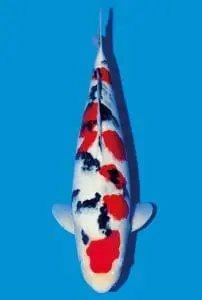
SHOWA SANSHOKU:
Showa is one of the youngest varieties of koi fish. It was only perfected in 1965 during the Showa era in Japan, after which it was named. Showa first appeared in 1927 when a breeder named Jukichi Hoshino crossed Kohaku (white-red color) with Ki Utsuri (yellow fish with black stripes). Showa didn’t immediately become popular because the yellow color of Ki Utsuri resulted in offspring with unpleasant, unattractive red and white colors.
It wasn’t until the 1960s that another breeder, Tomiji Kobayashi, crossed his Showa with Kohakus that had intense red color, resulting in more attractive Showa known as Kobayashi Showa. This lineage is the basis for most modern Showa and is often referred to as the old-style Showa.
Showa has a black body with white (shiro) and red markings. A high-quality Showa will be predominantly black with just enough white to accentuate it. Their hi should be bright and vibrant with sharp edges. The sumi should blend with their fins, called motoguro. A highly sought-after pattern on Showa is sumi flame on their head. It’s very challenging to breed high-quality Showa because their patterns constantly change during the juvenile stage and don’t become permanent until they mature.
It’s difficult to distinguish Showa and Sanke because they look very similar, but don’t worry! There are many ways to tell them apart, but just remember this characteristic sign: Showa will always have more black color than Sanke, and if it has black color on the head, it’s Showa!

CHAGOI:
Chagoi is the gentle giant, known for greeting their owners when approached and even eating out of people’s hands!
This special type of koi fish will grow faster in size than most others due to its huge appetite. Most adults will grow to 100cm or more. The general rule is that if a young Chagoi is well-built and robust, it means it will grow into a large fish as an adult.
Chagoi is named after the Japanese word for “tea” because the most valuable and sought-after Chagoi will be a beautiful, milky brown color (light brown). However, they can come in many different shades of brown, and sometimes even green. Some popular types of Chagoi include Rootbeer Chagoi (reddish-brown), Green Chagoi (pale green), and Brown Chagoi (range from light brown to dark brown).
Different colors will be judged according to their own category and will have their own unique personalities/qualities. But generally, a good-quality Chagoi will have consistent color, a large and full body, and scales that align with each other.
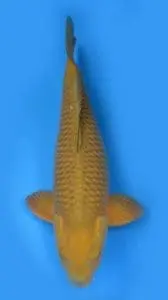
TANCHO:
While all koi fish hold great cultural significance in Japan, Tancho takes things to another level. Not only do they obviously resemble the Japanese flag, but they are also named after the sacred Japanese crane (Grus japonensis), known as “tancho” in Japanese. These cranes are considered mythical creatures as they live over a thousand years and are a symbol of luck and fidelity.
Tanchos are one of the rarest types of koi fish because they cannot be selectively bred. This is because they are technically Kohaku, Taisho, or Showa that are born accidentally with just one red spot on their head instead of the entire pattern (hi).
Selective breeding for them is extremely difficult because there are a plethora of genetic alleles responsible for koi coloring and pattern, so this type is often sought after for its rarity and the inability to consistently or in large numbers breed even among Gosanke types. If you want to have a specific type of koi fish, like Tancho, there is always a significant chance that even breeding with two Tancho parents will produce offspring that look completely different.
All Tancho koi fish will have the characteristic red spot, but the color of their body will vary depending on the type of parent. Their body can be pure white (Tancho Kohaku), white with small black spots (Tancho Sanke), or white with large black bands (Tancho Showa). The perfect Tancho will have a pure white base, black-ink spot sumi, and a crimson red spot in the center of the head. It is acceptable for this spot to come in an oval, heart-shaped, or diamond shape, but the circle is the most popular.
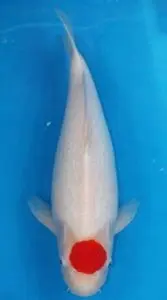
UTSURI:
Utsuri, also known as Utsurimono, is a variety derived from Showa koi fish. It took almost 65 years to perfect Utsuri, but the results were worth the wait!
Utsuri is a stunning variety of koi fish known for its highly contrasting sumi patterns and other prominent colors. Currently, there are only three types of Utsuri fish. Shiro Utsuri is black and white, Hi Utsuri is black and red, and Ki Utsuri is black and yellow.
A high-quality Utsuri will have ink-black sumi and rich, pronounced color – whether it’s white, red, or yellow – with clear edges. Ideally, it will have something called hachiware: black on one side of the head and pronounced color on the other. Although breeders can produce attractive Utsuri, they rarely win at shows because they do not grow to a size suitable for exhibition.
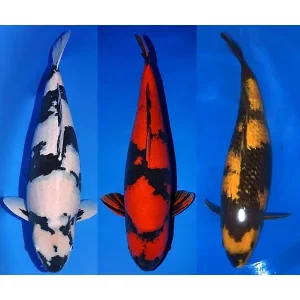
ASAGI:
Unlike many other varieties of koi fish, Asagi has a subdued color that is considered an acquired taste. Nevertheless, they are among the most popular in the koi community!
Asagi has metallic blue-gray scales on their backs with a diamond-like scale pattern. They also have bright red markings (hi) on their sides, undersides, and tails that stand out in contrast to the rest of their subdued bodies. Some Asagi have more red coloration than others (Hi Asagi), while others may have a white stripe between the gray scales and the red hi (Taki Asagi).
It is very difficult to breed a flawless Asagi. A good quality Asagi will have a clean white head, but they are often born with gray heads. Their hi should be symmetrical and well-defined, without scattered pigmentation on the other colors of their body. Many breeders also prefer their Asagi to have red eyes instead of the standard black, which is only possible through a genetic mutation.
A unique (and somewhat intimidating) feature of Asagi is that they are often born with translucent skin on their heads, allowing their skull to be visible. Fortunately, they always grow out of this.
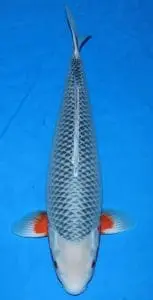
BEKKO:
Bekko is a variety known for its simplicity. They can come in three different base colors: white (Shiro Bekko), red (Aka Bekko), and yellow (Ki Bekko). Shiro Bekko is the most common, while Ki Bekko is the rarest.
After their base color, Bekko have scattered but balanced black markings (sumi) that run down their backs. High-quality Bekko have bright, vibrant colors, ink-black sumi, and preferably a clean white head. Their sumi should start precisely at the shoulder and continue down to the tail. It is also desirable for them to have blue eyes.
It should be noted that if Shiro Bekko has any red marking, it automatically classifies as Sanke, even if it’s just a small dot. The same applies if Ki or Aka Bekko have any white markings.
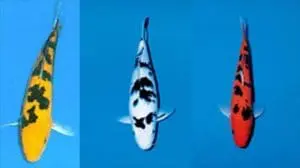
SHUSUI:
In the world of koi fish, it’s possible for a koi to be scaleless. This characteristic is called Doitsu, and the Shusui was the first of its kind!
Shusui were created by crossing Doitsu-goi (scaleless German carp) with Asagi, and the result was essentially an Asagi without scales. This may not seem exciting because any koi variety can be Doitsu; however, Shusui is significant for its history as the first successful Doitsu variety and because, along with Asagi, it’s the only other koi variety with a blue coloration.
Since Shusui are scaleless fish, they can better showcase their unique color. Just like Asagi, they have a blue pattern on their backs, red (hi) running along their lateral sides, and white (shiro) in between. A high-quality Shusui will have good symmetry along the lateral line of their backs as well as hi on their cheeks, head, fins, and of course, along their sides.
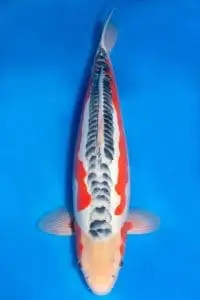
KOROMO:
The word “koromo” in Japanese means “clothed,” which perfectly describes the unique coloration of scales on the Koromo variety.
The Koromo variety was created by breeding a male Kohaku with a female Asagi. Therefore, Koromo has the red (hi) markings characteristic of Kohaku, with an indigo hue from the Asagi overlaying the tips of the scales. They can be Ai Koromo (red-white), Koromo Sanshoku (red-white with small black speckles), Koromo Showa (red-white with large black patches), and several others.
A high-quality Koromo should have a beautiful Kohaku pattern with an indigo shade resembling a crescent moon on their scales. This hue should be neat and always appear only on their hi. This shade may darken with age, which can become too dominant to be considered high quality as it grows.
It’s very challenging to breed good Koromo due to all these specific qualifications.
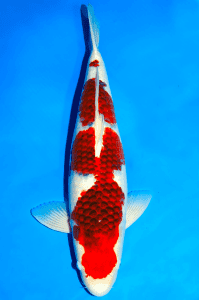
GOSHIKI:
“Goshiki” in Japanese means “five colors,” referring to Goshiki koi fish, which are a combination of black, red, white, brown/gray, and blue. A true Goshiki should have a white base with Kohaku-like hi patterning, accentuated by reticulated (or net-like) patterns of black, blue, and gray or brown. Their hi plates should be distinctly bright and bold, while their fins should always be entirely white. Often, the colors of the reticulation intertwine and blend, making it a bit challenging to distinguish the five different colors in most Goshiki koi fish.
Goshiki koi fish were originally bred in the early 1900s, but their exact origins are somewhat disputed. Some believe that the first Goshiki was bred by crossing Sanke to achieve vibrant white and red colors with Asagi to get the colorful reticulation. Another commonly held theory is that Asagi was bred with Kohaku. Genetic studies seem to point to the latter.
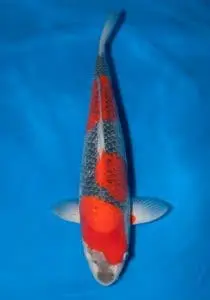
KIN GIN RIN:
Kin Gin Rin isn’t actually a specific breed of koi fish but rather refers to a type of scale. Kin Gin Rin roughly translates to “golden silver reflective scales” and pertains to the metallic, shiny, reflective scales of koi fish. Within this, there are two subspecies: Gin Rin koi have silver or bright white scales, while Kin Rin koi have scales with reflective golden or sometimes bronze tones. The reason behind these diamond-like scales is the presence of a crystalline pigment known as guanine, which naturally exists in some fish as a means to aid in environmental adaptation and less visibility to predators. Koi breeders discovered this and selectively bred to emphasize this trait in Kin Gin Rin koi fish.
To be considered a Kin Gin Rin koi fish, the fish must have at least three full rows of metallic scales. Additionally, Kin Gin Rin will have the same number of metallic scales throughout their entire lifespan. For this reason, this type of koi fish will appear brighter with more intense reflections when young than as mature Kin Gin Rin. As the fish ages, skin begins to form around the scales, making them more spaced out. This is called Furkurin. Sometimes, the skin itself also shines metallically (Hikari), giving the fish an appearance even more diamond-like than when it was young. This is often highly desirable in koi fish competitions.
All types of koi fish can possess Kin Gin Rin scales, including Kohaku, Chagoi, Showa, and others.
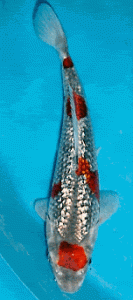
OGON:
Ogon koi are koi fish that possess only one solid color and are divided into two main categories: platinum and yamabuki. Platinum Ogon are monochromatic, shiny silver-white, while yamabuki Ogon come in warmer shades such as gold, yellow, or bronze. Ogon koi can be Doitsu (scaleless) or Kin Gin Rin (metallic scales). A true Ogon should appear metallic and shiny, whether it’s due to Hikari (shiny skin) in the absence of scales or Kin Gin Rin scales.
Ogon koi are relatively new compared to many others that were developed hundreds of years ago. Allegedly, in the 1910s, some children were playing by the river and caught a dark-colored carp with shiny scales. A local man, Sawata Aoki, adopted the carp and spent the next few decades selectively breeding to create koi fish with completely metallic bodies. It took him 25 years to create the first Ogon koi.
These are some of the friendliest and most communicative koi fish, making them favorites among koi fish owners, even if they don’t compete.
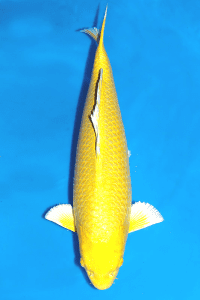
– Nordin Trobradovic, Koi HR
Prijavite se na naš newsletter kako biste primali najnovije vijesti i informacije vezane uz KOI & BONSAI SHOW ZAGREB.
